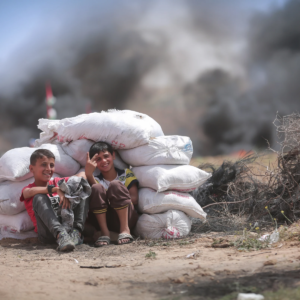The Impact of Genocide on Gaza’s Children: A Setback for Education by Up to Five Years
The Impact of Genocide on Gaza’s Children: A Setback for Education by Up to Five Years

One year after the devastating events of October 7th, the ongoing conflict in Gaza has plunged children into a series of compounded crises. The war is not only shattering lives but also pushing Gaza’s education system to the brink of collapse, with some experts predicting that it could set children’s learning back by as much as five years. This devastating impact risks the emergence of a lost generation of Palestinian youth, burdened by trauma, displacement, and a lack of educational opportunities.
A new report, conducted in collaboration with the United Nations Relief and Works Agency for Palestinian Refugees in the Near East (UNRWA), outlines the immense toll the war has taken on the region’s children, educators, and the broader learning environment. The findings make it clear that without urgent intervention, the future of Gaza’s children remains dangerously uncertain.
The Unfolding Educide in Gaza
Gaza’s education system was already struggling before the current war. Since 2019, children have lost over 14 months of schooling due to the combined effects of COVID-19, previous military operations, and ongoing conflict. Even under the most optimistic scenarios, which assume an immediate ceasefire and rapid rebuilding efforts, students are expected to lose at least two full years of learning. Should the conflict persist until 2026, educational setbacks could extend to five years or more.
These figures do not fully capture the broader challenges Gaza’s children face. In addition to interrupted schooling, the traumatic experiences of war, hunger, and forced displacement are deepening the crisis. Children living in conflict zones, like Gaza, are more than 1.5 times as likely to be out of school compared to their peers in more stable environments.
The Human Toll of the Genocide
The numbers paint a grim picture. According to the United Nations Office for the Coordination of Humanitarian Affairs (OCHA), by August 2024, over 10,600 children and 400 teachers had been killed in Israeli military operations. Thousands more have been injured or displaced, with hundreds of thousands now living in shelters where educational access is severely limited.
Over 90% of schools in Gaza have been damaged or destroyed, leaving many beyond repair. While UNRWA has managed to provide education to around 8,000 children in shelters, the scale of need far exceeds current capacities. The psychological impact on children is another alarming concern, with organizations like Save the Children reporting widespread fear and hopelessness among young people, many of whom have grown up knowing nothing but conflict.
The war’s physical toll on children is also heartbreaking. It is estimated that more than 10 children lose limbs daily, and many others are facing invisible disabilities like post-traumatic stress disorder (PTSD). This places additional strain on an education system already ill-equipped to handle the special needs of disabled students.
The Strain on Teachers and Educators
Educators in Gaza have demonstrated extraordinary resilience, continuing to teach in the face of unimaginable challenges. Yet they, too, are buckling under the immense pressure. Many teachers are struggling to cope with their own displacement, trauma, and the daily violence they and their families experience. Without adequate support, the education system’s recovery will be severely hindered.
Urgent Actions: What Can Be Done?
The study calls for immediate, large-scale international intervention to prioritize education in Gaza’s humanitarian response. If action is not taken swiftly, Gaza’s children will continue to fall further behind, deepening an already critical crisis. Education must not only be preserved but also reinforced as a key component of recovery. Below are key actions for both those working on the ground and advocates operating remotely:
For Practitioners on the Ground:
- Foster Resilience Through Professional Psychosocial Support: Teachers need trauma-informed training to help children cope with the psychological scars of war. Integrating psychosocial support into education is critical.
- Establish Safe Learning Spaces: Temporary learning centers and mobile educational units must be deployed in safer areas to maintain continuous learning. Supporting educators is essential to addressing the trauma and challenges caused by displacement.
- Provide Targeted Support for Special Needs Education: With many children facing both visible and invisible disabilities, it is crucial to develop an education system that can accommodate these specific needs.
For Remote Advocates:
- Raise Global Awareness: Advocacy campaigns must highlight the severity of the educational crisis in Gaza, sharing personal stories of affected children and teachers to galvanize global support.
- Push for Policy Change and Increased Funding: Education is a lifeline in conflict zones, yet only 3.5% of aid to Gaza has been allocated for education. Advocates must pressure donors and international organizations to prioritize educational aid.
- Build Global Solidarity Networks: Global educators, NGOs, and advocacy groups can support efforts in Gaza by sharing resources, best practices, and providing remote mentoring for teachers on the ground.
The Risk of a Lost Generation
If we fail to prioritize Gaza’s children and their right to education, we risk losing an entire generation, not only to learning loss but also to despair and disillusionment. The long-term consequences of such neglect could be profound, fostering a generation that feels abandoned by the world and susceptible to extremism.
Education must be our collective priority. Without it, Gaza’s future—and the future of its children—hangs in the balance.

